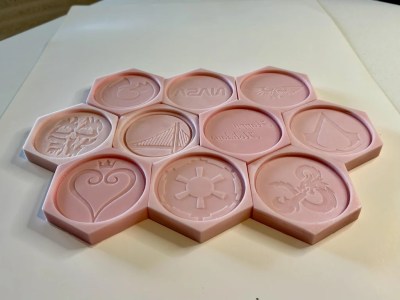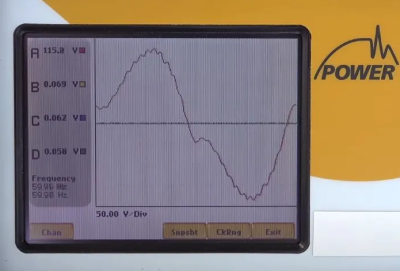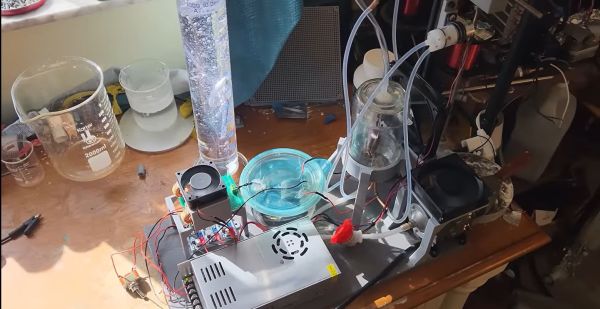How long does it take a team of rocket scientists to remove two screws? When the screws they’re working on are keeping a priceless sample of asteroid safe, it’s about three months. That’s how long NASA has been working on the OSIRIS-REx sample return canister, which came back to Earth from asteroid Bennu back in September. The container was crammed full of asteroid bits, thanks in part to an overly energetic impact between the sample-collecting boom and Bennu. There was so much stuff that planetary scientists were able to recover about 70 grams of material that was covering the outside of the sealed container; this must have been a boon to the engineers, who got to figure out how to open the jammed cover of the container without anyone breathing down their necks for samples to study. The problem was a pair of stuck fasteners out of the 35 holding the lid on the container; the solution was far more complicated than a spritz of WD-40 and a little bit of heating with an oxy-acetylene torch. Engineers had to design two “clamp-like tools” and test them on a mock-up to make sure they wouldn’t contaminate the sample. We’d love to know more about these tools; trust us, we’ll be looking into this closely. If we find anything, a full article will be forthcoming.
Linux Fu: Name That Tune
If you aren’t old enough to remember, the title of this post refers to an old game show where contestants would try to name a tune using the fewest possible notes. What can we say? Entertainment options were sparse before the Internet. However, using audio fingerprinting, computers are very good at pulling this off. The real problem is having a substantial library of fingerprints to compare with. You can probably already do this with your phone, and now you can do it with your Linux computer.
In all fairness, your computer isn’t doing the actual work. In fact, SongRec — the program in question — is just a client for Shazam, a service that can identify many songs. While this is mildly interesting if you use a Linux desktop, we could also see using the same technique with a Raspberry Pi to get some interesting projects. For example, imagine identifying a song playing and adjusting mood lighting to match. A robot that could display song information could be the hit of a nerdy party.
How To Refrigerate With Urine
It’s often said that the best science experiments are the ones which do not require any special devices or ingredients, which makes the use of what naturally comes out of one’s body clearly one of the winners. It’s also the beginning of yet another [Hyperspace Pirate] chemistry video that’s both fascinating and unforgettable — this time introducing a considerable collection of urine, and the many uses of the urea in it, including its use for refrigeration.

As icky as this may sound, it doesn’t even rank in the top ten of quaint things people have historically done with urine, so extracting urea from it is rather benign. This is performed by adding sodium hydroxide to the starting component after heating, which creates gaseous ammonia (NH3) which was then condensed into its liquid (dissolved) form. In order to create the target compound – being ammonium nitrate – nitric acid (HNO3) had to be created first.
For this the older, but cheaper and easier Birkeland-Eyde process was used. This uses high-voltage electrical arcs to break down the nitrogen and oxygen in the air and cause the formation of nitric oxide (NO), that subsequently reacts with atmospheric oxygen to form nitrogen dioxide (NO2). Running the NO2 through water then creates the desired HNO3, which can be combined with the ammonia solution to create ammonium nitrate. The resulting solution was then evaporated into solid ammonium nitrate, to use it in an aluminium cooling cylinder, with freshly added water.
This is the simplest way to use the cooling effect of such solutions (pictured), but the benefit of ammonium nitrate over the original urea seems minimal. The low efficiency of this cooling approach means that the next use of urine will involve a much more efficient vapor-absorption cycle, which we’re sure everyone is squeezing their legs together for in anticipation.
We’ve been covering the refrigeration experiments [Hyperspace Pirate] has been conducting for some time now. If you’re into the science of making things cold check out how seashells can be turned into dry ice, or what goes into building a home cryocooler.
3D Printed Cookies, Sort Of
Are there any cookies that taste better than the ones you make yourself? Well, maybe, but there’s a certain exquisite flavoring to effort. Just ask [jformulate], who created these custom chocolate-topped butter cookies using a mixture of 3D printing, silicone, and of course, baking and tempering.
 [jformulate] did this project along with a makerspace group, and the first thing they did was decide on some images for the cookies. Once a hexagon-shaped mold was created in Fusion360, the images were added in. Some had to be height-adjusted in order for the detail to come out.
[jformulate] did this project along with a makerspace group, and the first thing they did was decide on some images for the cookies. Once a hexagon-shaped mold was created in Fusion360, the images were added in. Some had to be height-adjusted in order for the detail to come out.
Once these positives were printed, it was time to make the food-safe silicone molds that would form the custom chocolate toppers. If you don’t have a vacuum de-gasser, [jformulate] recommends pouring a thin stream from a high place to avoid air bubbles. You can always tap the mold several times on a flat surface as well to bring trapped air to the top.
Finally, it’s time to make cookies. [jformulate] has good instructions for tempering chocolate, as well as a recipe for the butter cookies that support the designs. As a bonus, [jformulate] shows how to make a fish-shaped hot chocolate bomb, and made Jolly Rancher (sadly not Wrencher) medallions using the silicone molds and a microwave.
For the semi-disappointed, directly 3D printing cookies is definitely a thing.
How Good Is The Cheapest Generator On Amazon?
Although an internal combustion engine-based generator isn’t exactly one of the most complicated contraptions, any time that you combine something that produces power with electrical devices, you generally like to know how safe it is. Even more so when it’s a $139 generator you got off Amazon, like the PowerSmart 1200 Watt (1000 continuous) that the [Silver Cymbal] took a gander at recently. They used an expensive professional power analyzer to look at more than just the basic waveform of the 120 VAC output to figure out what kind of devices you’d feel comfortable connecting to it.

On the unit there is a single AC output, which a heater got attached to serve as a load during testing, but before that, the properties out of the output voltage were analyzed without any load. This showed a highly erratic waveform, as the generator clearly was unable to synchronize and produced a voltage within a wide range, immediately disqualifying it for connecting to sensitive electronics. Things got less dire once the load was hooked up and turned up to use up a big chunk of the available continuous power.
Although being far from a perfect sine wave, the output now looked much better, with all properties including the total harmonic distortion (THD) being just a hair over 20% and hitting just over 60 Hz on the frequency.
Definitely not a great result, but as a cheap unit to keep around for powering things like heaters and power tools that aren’t too fussy about how clean the power is, one could do a lot worse.
Continue reading “How Good Is The Cheapest Generator On Amazon?”
2023: As The Hardware World Turns
We’ve made it through another trip around the sun, and for the first time in what feels like far too long, it seems like things went pretty well for the hackers and makers of the world. Like so many, our community suffered through a rough couple of years: from the part shortages that made building even the simplest of devices more expensive and difficult than it should have been, to the COVID-mandated social distancing that robbed us of our favorite meetups. But when looking back on the last twelve months, most of the news was refreshingly positive.

Oh sure, a trip to to the grocery store can lead to a minor existential crisis at the register, but there’s not much we at Hackaday can do about that other than recommend you some good hydroponics projects to help get your own home farm up and running.
As has become our New Year tradition, we like to take this time to go over some of the biggest stories and trends that we picked up on from our unique vantage point. Some will be obvious, but there’s always a few that sneak up on us. These posts tend to make for interesting reading in the future, and if you’ve got the time, we’d recommend going back and reading the previous entries in this series and reminiscing a bit.
It’s also a good time to reflect on Hackaday itself — how we’ve grown, the things that have changed, and perhaps what we can do better going forward. Believe it or not we do read all of the feedback from the community, whether it’s in the comments of individual posts or sent into us directly. We couldn’t do this without readers like you, so please drop us a line and let us know what you’re thinking.
So before we get any farther into 2024, let’s wind back the clock and revisit some of the highlights from the previous year.
DIY Tube Lights Look Amazing For Just $50 A Piece
It’s the future. We should have weird glowy lights everywhere, all over our homes, cars, and businesses. In the automotive world, luxury automakers are doing their part with LED ambient lighting systems, but the rest of us have to step up. [Super Valid Designs] has developed an excellent modular DMX lighting rig that’s fit for this purpose; the rest of us just have to get to work and build our own! (Video, embedded below.)
The design relies on hot-swapping powered bases that let a variety of different lights to be swapped in as needed. They use a custom four-pin socket designed by [Super Valid Designs] using PVC and ABS plumbing and conduit parts and tent pole springs from Home Depot. There’s a 3D-printable version, too, which is useful for those around the world that can’t get access to American standard gear easily. Anyone from the Nerf scene will understand this frustration well.
The real cool part of the modular rig, though, are the tube fixtures. There’s a ball design too, but they don’t look quite as future-cool as the tubes. They use fluorescent tube protectors as a cheap source of clear tubes, and use plumbing and conduit parts to make easy-insert connectors for pairing with the modular bases. Light is courtesy of old-school non-addressable RGB LED strips, attached to flat aluminium trim with their own adhesive combined with a wrap of clear packing tape as well. The LED strip is attached to one side of the tube, with parchment paper layered inside the tubes to act as a diffuser.
Building in quantities of 8 or more, [Super Valid Designs] reckons that the tubes can be built for $50 each or less. Of course, that adds up to a few hundred dollars in total, but the results speak for themselves.
If you’re thinking of tackling this project, but DMX is beyond your current skillset, fear not. We’ve got just the primer to get you started! Video after the break.
Continue reading “DIY Tube Lights Look Amazing For Just $50 A Piece”


















